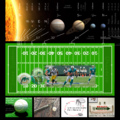File:Solar System to Scale to a Football Field.jpg

原始文件 (2,688 × 1,520像素,文件大小:1.53 MB,MIME类型:image/jpeg)
摘要
| 描述Solar System to Scale to a Football Field.jpg |
English: This image is unique in that it shows both the sizes and distances of the Solar System to scale.
It shows that if the Sun-Neptune distance of the Solar System were scaled down to the 100-yard length of a football field (yellow lines point to goal line to goal line span, roughly 13 meters shorter than a standard soccer, or Association football field), then the Sun and eight planets would be small enough to hold in the palm of a person's hand. The inset shows all 9 objects upclose to just one yard, and this is done to show that typical Solar System depictions are grossly distorted by several orders of magnitude. (To view this image without this inset nor with any markings, click here.) SIZES:
Jupiter along with all the terrestrial planets are located well within the "red zone", to use a term from American football. The exact scale factor is 49,250,000,000-to-1. Precise numbers for the mean orbit distances of the planets as a percent of Neptune's mean distance are (Mercury through Neptune respectively): 1.287%, 2.402%, 3.323%, 5.063%, 17.292%, 31.712%, 63.786%, and 100%. Vertical lines (in white) point to the exact locations where the bodies are found (abbreviating to just the first initial). At the top of each bar is a horizontal line indicating the eccentricity of each orbit, with the 'T' showing the closest and furthest away from the Sun it gets (perihelion and aphelion). At the bottom of each of these are a pair of black lines which likewise show the perihelion and aphelion, but the pair is split to also show how high above and below the field the orbit goes. So this pair of lines simultaneously shows the orbit inclination and eccentricity. This defines a rectangular box that when swept around the Sun forms a "washer" of perfect cylindrical shape within which the orbit of the body will be contained. The orbit of Ceres ("C") has an inclination greater than any planet. And Pluto ("P") has an even bigger inclination, at 15.6° off of the invariable plane (see 3RD DIMENSION section below). Pluto's tilt takes its orbit far below the level of the field with the point indicated near the bottom right of the image, and its orbit goes well above the boundary of this image so is not indicated. Pluto's orbit is located 130 yards away from the Sun, so it's horizontal eccentricity line is a pointer, while showing how the perihelion of Pluto's orbit is actually closer to the Sun than Neptune's.
Distance = Rate x Time The speed of light in a vacuum is a constant rate, so it can be useful for measuring large distances. In the Solar System, here is the time it takes for light from the Sun to reach:[1] Light-distance from Sun —————————————————————————————————————————————— Mercury 193.0 seconds = 3min 13sec ≈ 3¼min Venus 360.0 seconds = 6min Earth 499.0 seconds = 8min 19sec ≈ 8⅓min Mars 759.9 seconds = 12min 39.9sec ≈ 12⅔min Ceres 1381.0 seconds = 23min 1sec ≈ 23min Jupiter 2595.0 seconds = 43min 15sec = 43¼min Saturn 4759.0 seconds = 1hr 19min 19sec ≈ 1⅓hrs Uranus 9575.0 seconds = 2hrs 39min 35sec ≈ 2⅔hrs Neptune 14998.0 seconds = 4hrs 9min 58sec ≈ 4⅙hrs Pluto 19680.0 seconds = 5hrs 28min 0sec ≈ 5½hrs ——————————————————————————————————————————————
———————————————————————————————————————————
Planet Inclination and
Scaled Maximum Height Above/Below The Field
———————————————————————————————————————————
Ecliptic Plane Invariable Plane
———————————————————————————————————————————
Mercury 7.01° 6.34°
0.475'=5.703" 0.426'=5.116"
———————————————————————————————————————————
Venus 3.39° 2.19°
0.426'=5.113" 0.275'=3.304"
———————————————————————————————————————————
Earth ---- 1.57°
0 0.273'=3.278"
———————————————————————————————————————————
Mars 1.85° 1.67°
0.490'=5.884" 0.443'=5.312"
———————————————————————————————————————————
Jupiter 1.31° 0.32°
1.186'=14.232" 0.290'=3.477"
———————————————————————————————————————————
Saturn 2.49° 0.93°
4.133'=49.598" 1.544'=18.530"
———————————————————————————————————————————
Uranus 0.77° 1.02°
2.572'=30.859" 3.406'=40.877"
———————————————————————————————————————————
Neptune 1.77° 0.72°
9.266'=111.195" 3.770'=45.238"
———————————————————————————————————————————
The largest excursion of any of the planets is by Neptune, reaching at most 9.266 feet (2.824 meters) above or below the football field (with the field defined as the ecliptic plane). All other planets remain much closer to the common plane. In the invariable plane, the maximum height is again by Neptune reaching up to 3.77 feet (1.15 meters) which is shorter than the height of an average 7-year old child.
 Solar System scaled to a football field.png |
| 日期 | |
| 来源 | 自己的作品 |
| 作者 | Tdadamemd |
| 其他版本 |
Image with no inset or markings: Solar System to Scale to a Football Field (no inset).jpg  Planets and sun size comparison (inset scaled to football field).jpg |
许可协议
- 您可以自由地:
- 共享 – 复制、发行并传播本作品
- 修改 – 改编作品
- 惟须遵守下列条件:
- 署名 – 您必须对作品进行署名,提供授权条款的链接,并说明是否对原始内容进行了更改。您可以用任何合理的方式来署名,但不得以任何方式表明许可人认可您或您的使用。
- 相同方式共享 – 如果您再混合、转换或者基于本作品进行创作,您必须以与原先许可协议相同或相兼容的许可协议分发您贡献的作品。
说明
此文件中描述的项目
描繪內容
25 3 2014
文件历史
点击某个日期/时间查看对应时刻的文件。
| 日期/时间 | 缩略图 | 大小 | 用户 | 备注 | |
|---|---|---|---|---|---|
| 当前 | 2016年6月8日 (三) 20:48 |  | 2,688 × 1,520(1.53 MB) | Tdadamemd | Major update: "Down Markers" added to point out exact locations, eccentricites, inclinations, etc. Also marked orbit path of largest planet. |
| 2014年4月5日 (六) 23:12 |  | 2,688 × 1,520(1.3 MB) | Tdadamemd | Adding more emphasis to the lines that highlight the location of the 100-yard span between the goal lines, now colored yellow. | |
| 2014年4月5日 (六) 08:03 |  | 2,688 × 1,520(1.36 MB) | Tdadamemd | User created page with UploadWizard |
文件用途
以下页面使用本文件:
全域文件用途
以下其他wiki使用此文件:
- en.wikipedia.org上的用途

